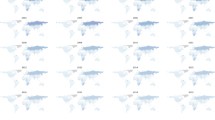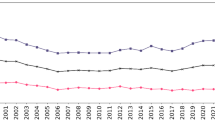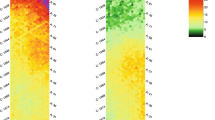Abstract
Global trends and future projections of suicide mortality are crucial to providing policy decision-makers with insights into estimating the global and future burden of suicide; however, they require techniques accounting for the effects of age, period and cohort on trends in suicide mortality and considering various factors such as population growth and aging. Therefore, we aimed to estimate the global trends in suicide mortality rates from 1990 to 2021 and the future projection of suicide deaths until 2050 across 102 countries. Global trends were calculated using a locally weighted scatter-plot smoother (LOESS) curve, and the association between the rates and socioeconomic and geographical indicators was investigated. The study also projected future suicide mortality rates up to 2050 using the Bayesian age–period–cohort model. In addition, a decomposition analysis was performed to identify the variations in suicide deaths, specifically examining factors such as population growth, aging and epidemiological changes. Of the 102 countries included in the analysis of suicide mortality, 54 were high-income countries (HICs) and 48 were low- and middle-income countries (LMICs). The LOESS estimate of the global suicide mortality rate decreased from 10.33 (95% confidence interval, 9.67–10.99) deaths per 100,000 people in 1990 to 7.24 (6.58–7.90) deaths per 100,000 people in 2021. Notably, overall global suicide mortality rates were higher among males compared with females, with males showing a decline from 16.41 (15.23–17.58) in 1990 to 11.51 (10.33–12.68) in 2021, and females from 4.65 (4.41–4.89) in 1990 to 3.22 (2.98–3.46) in 2021. In addition, HICs also had higher suicide mortality rates, from 12.68 (11.96–13.40) in 1990 to 8.61 (7.89–9.33) in 2021, compared with LMICs, which showed 7.88 (6.93–8.84) in 1990 and 5.73 (4.77–6.69) in 2021. We also identified an association between the age-standardized suicide rates and several parameters, including the Human Development Index (β, 24.250; P = 0.001), Sociodemographic Index (β, 0.091; P < 0.001), reverse Gender Gap Index (β, −39.913; P = 0.002), Gender Inequality Index (β, 13.229; P = 0.016) and latitude (β, 23.732; P < 0.001). The future predicted number of global suicide deaths up to 2050 would slightly decrease from 8.60 (95% credible interval, 8.40–8.83) deaths in 2021 to 8.42 (6.60–10.61) in 2030, 7.39 (4.25–13.17) in 2040 and 6.49 (2.19–17.57) in 2050. Although population growth and aging had contributed to an increase in the number of deaths, the overall count in 2021 had decreased compared with 1990, primarily due to the decline in the age-standardized suicide mortality rates. A global trend for a decrease in suicide mortality rate was observed from 1990 to 2021. Reflecting the overall decline, future suicide deaths are forecasted to decrease up to 2050 at the global level, with certain groups and countries remaining more vulnerable to suicide deaths. Therefore, these findings suggest the need for more effective strategies and policies to reduce suicide mortality.
This is a preview of subscription content, access via your institution
Access options
Subscribe to this journal
Receive 12 digital issues and online access to articles
$79.00 per year
only $6.58 per issue
Buy this article
- Purchase on SpringerLink
- Instant access to full article PDF
Prices may be subject to local taxes which are calculated during checkout





Similar content being viewed by others
Data availability
The data used in this study are publicly available from the WHO mortality database and can be directly downloaded from the following link: https://www.who.int/data/data-collection-tools/who-mortality-database.
Code availability
All code used for this analysis is publicly available online via GitHub at https://github.com/CenterForDH/WHO_suicide.git. The statistical code is available from D.K.Y.
References
Naghavi, M. et al. Global, regional, and national burden of suicide mortality 1990 to 2016: systematic analysis for the Global Burden of Disease Study 2016. Br. Med. J. 364, l94 (2019).
Suicide Worldwide in 2019: Global Health Estimates (World Health Organization, 2021).
Ilic, M. & Ilic, I. Worldwide suicide mortality trends (2000–2019): a joinpoint regression analysis. World J. Psychiatry 12, 1044–1060 (2022).
The Sustainable Development Goals Report (United Nations, 2017).
Comprehensive Mental Health Action Plan 2013–2030 (World Health Organization, 2021).
Live Life: an Implementation Guide for Suicide Prevention in Countries (World Health Organization, 2021).
National Suicide Prevention Strategies: Progress, Examples and Indicators (World Health Organization, 2018).
Zalsman, G. et al. Suicide prevention strategies revisited: 10-year systematic review. Lancet Psychiatry 3, 646–659 (2016).
WHO Mortality Database (World Health Organization, accessed 23 Dec 2023); https://platform.who.int/mortality
Yip, P. S. F., Zheng, Y. & Wong, C. Demographic and epidemiological decomposition analysis of global changes in suicide rates and numbers over the period 1990–2019. Inj. Prev. 28, 117–124 (2022).
He, J. et al. Time trends and predictions of suicide mortality for people aged 70 years and over from 1990 to 2030 based on the Global Burden of Disease Study 2017. Front. Psychiatry 12, 721343 (2021).
Global Burden of Disease (GBD) (The Institute for Health Metrics and Evaluation, accessed 28 Dec 2023); https://www.healthdata.org/research-analysis/gbd
Turecki, G. et al. Suicide and suicide risk. Nat. Rev. Dis. Primers 5, 74 (2019).
Pirkis, J., Dandona, R., Silverman, M., Khan, M. & Hawton, K. Preventing suicide: a public health approach to a global problem. Lancet Public Health 9, e787–e795 (2024).
Martínez-Alés, G., Jiang, T., Keyes, K. M. & Gradus, J. L. The recent rise of suicide mortality in the United States. Annu. Rev. Public Health 43, 99–116 (2022).
Chang, S. S., Stuckler, D., Yip, P. & Gunnell, D. Impact of 2008 global economic crisis on suicide: time trend study in 54 countries. Br. Med. J. 347, f5239 (2013).
Lewitzka, U., Sauer, C., Bauer, M. & Felber, W. Are national suicide prevention programs effective? A comparison of 4 verum and 4 control countries over 30 years. BMC Psychiatry 19, 158 (2019).
Schlichthorst, M. et al. Trends in suicide-related research in Australia. Int. J. Ment. Health Syst. 14, 2 (2020).
Hedley, D., Stokes, M. A. & Trollor, J. N. Suicide by young Australians, 2006–2015: a cross-sectional analysis of national coronial data. Med. J. Aust. 216, 54 (2022).
Stefanac, N. et al. Are young female suicides increasing? A comparison of sex-specific rates and characteristics of youth suicides in Australia over 2004–2014. BMC Public Health 19, 1389 (2019).
Hill, N. T., Witt, K., Rajaram, G., McGorry, P. D. & Robinson, J. Suicide by young Australians, 2006–2015: a cross-sectional analysis of national coronial data. Med. J. Aust. 214, 133–139 (2021).
Dhungel, B., Sugai, M. K. & Gilmour, S. Trends in suicide mortality by method from 1979 to 2016 in Japan. Int. J. Environ. Res. Public Health 16, 1794 (2019).
Kino, S., Jang, S. N., Gero, K., Kato, S. & Kawachi, I. Age, period, cohort trends of suicide in Japan and Korea (1986–2015): a tale of two countries. Soc. Sci. Med. 235, 112385 (2019).
Sankoh, O., Sevalie, S. & Weston, M. Mental health in Africa. Lancet Glob. Health 6, e954–e955 (2018).
Freeman, A. et al. A cross-national study on gender differences in suicide intent. BMC Psychiatry 17, 234 (2017).
Iemmi, V. et al. Suicide and poverty in low-income and middle-income countries: a systematic review. Lancet Psychiatry 3, 774–783 (2016).
King, T. L. et al. Expressions of masculinity and associations with suicidal ideation among young males. BMC Psychiatry 20, 228 (2020).
Ventriglio, A., Torales, J., Castaldelli-Maia, J. M., De Berardis, D. & Bhugra, D. Urbanization and emerging mental health issues. CNS Spectr. 26, 43–50 (2021).
Lovero, K. L., Dos Santos, P. F., Come, A. X., Wainberg, M. L. & Oquendo, M. A. Suicide in global mental health. Curr. Psychiatry Rep. 25, 255–262 (2023).
Tollefsen, I. M., Hem, E. & Ekeberg, O. The reliability of suicide statistics: a systematic review. BMC Psychiatry 12, 9 (2012).
Chakrabartty, S. N. Methodological issues: gender related indices. Discov. Glob. Soc. 1, 4 (2023).
Stack, S. Contributing factors to suicide: political, social, cultural and economic. Prev. Med. 152, 106498 (2021).
King, T. L., Kavanagh, A., Scovelle, A. J. & Milner, A. Associations between gender equality and health: a systematic review. Health Promot. Int. 35, 27–41 (2020).
An, S. et al. Global prevalence of suicide by latitude: a systematic review and meta-analysis. Asian J. Psychiatry 81, 103454 (2023).
Jordans, M. J. et al. Suicide in South Asia: a scoping review. BMC Psychiatry 14, 358 (2014).
Mars, B., Burrows, S., Hjelmeland, H. & Gunnell, D. Suicidal behaviour across the African continent: a review of the literature. BMC Public Health 14, 606 (2014).
WHO Methods and Data Sources for Country-Level Causes of Death 2000–2019 (World Health Organization, 2020).
About the WHO Mortality Database 2024 (World Health Organization, accessed 12 Jan 2024); https://platform.who.int/mortality/about/about-the-who-mortality-database
Sinyor, M., Silverman, M., Pirkis, J. & Hawton, K. The effect of economic downturn, financial hardship, unemployment, and relevant government responses on suicide. Lancet Public Health 9, e802–e806 (2024).
Neilson, E. C., Singh, R. S., Harper, K. L. & Teng, E. J. Traditional masculinity ideology, posttraumatic stress disorder (PTSD) symptom severity, and treatment in service members and veterans: a systematic review. Psychol. Men Masc. 21, 578–592 (2020).
Niederkrotenthaler, T. et al. Association of Logic’s hip hop song “1-800-273-8255” with Lifeline calls and suicides in the United States: interrupted time series analysis. Br. Med. J. 375, e067726 (2021).
Viner, R. M., Hargreaves, D. S., Coffey, C., Patton, G. C. & Wolfe, I. Deaths in young people aged 0–24 years in the UK compared with the EU15+ countries, 1970–2008: analysis of the WHO Mortality Database. Lancet 384, 880–892 (2014).
Ebmeier, S. et al. Trends in international asthma mortality: analysis of data from the WHO Mortality Database from 46 countries (1993–2012). Lancet 390, 935–945 (2017).
Barco, S. et al. Trends in mortality related to pulmonary embolism in the European Region, 2000–15: analysis of vital registration data from the WHO Mortality Database. Lancet Respir. Med. 8, 277–287 (2020).
Eldridge, L., Garton, E. M., Duncan, K. & Gopal, S. Authorship of publications supported by NCI-funded grants involving low- and middle-income countries. JAMA Netw. Open 7, e243215 (2024).
Walker, R. W. et al. Stroke mortality in urban and rural Tanzania. Adult Morbidity and Mortality Project. Lancet 355, 1684–1687 (2000).
Pearson-Stuttard, J. et al. Modeling future cardiovascular disease mortality in the United States: national trends and racial and ethnic disparities. Circulation 133, 967–978 (2016).
Bray, F., Jemal, A., Grey, N., Ferlay, J. & Forman, D. Global cancer transitions according to the Human Development Index (2008–2030): a population-based study. Lancet Oncol. 13, 790–801 (2012).
Chong, B. et al. Trends and predictions of malnutrition and obesity in 204 countries and territories: an analysis of the Global Burden of Disease Study 2019. eClinicalMedicine 57, 101850 (2023).
2020: a critical year for women, gender equity, and health. Lancet 395, 1 (2020).
Turecki, G. & Brent, D. A. Suicide and suicidal behaviour. Lancet 387, 1227–1239 (2016).
Vyssoki, B., Kapusta, N. D., Praschak-Rieder, N., Dorffner, G. & Willeit, M. Direct effect of sunshine on suicide. JAMA Psychiatry 71, 1231–1237 (2014).
Babroudi, S., Weiner, D. E., Neyra, J. A. & Drew, D. A. Acute kidney injury receiving dialysis and dialysis care after hospital discharge. J. Am. Soc. Nephrol. 35, 962–971 (2024).
Schmid, V. J. & Held, L. Bayesian age–period–cohort modeling and prediction—BAMP. J. Stat. Softw. 21, 1–15 (2007).
Kiyoshige, E. et al. Projections of future coronary heart disease and stroke mortality in Japan until 2040: a Bayesian age–period–cohort analysis. Lancet Reg. Health West Pac. 31, 100637 (2023).
Qi, J. et al. National and subnational trends in cancer burden in China, 2005–20: an analysis of national mortality surveillance data. Lancet Public Health 8, e943–e955 (2023).
Nichols, E. et al. Estimation of the global prevalence of dementia in 2019 and forecasted prevalence in 2050: an analysis for the Global Burden of Disease Study 2019. Lancet Public Health 7, e105–e125 (2022).
Bertuccio, P. et al. Global trends in youth suicide from 1990 to 2020: an analysis of data from the WHO mortality database. eClinicalMedicine 70, 102506 (2024).
Seo, S. A Review and Comparison of Methods for Detecting Outliers in Univariate Data Sets (Univ. Pittsburgh, 2006).
Acknowledgements
This research was supported by the Basic Science Research Program through the National Research Foundation of Korea (NRF) funded by the Ministry of Education (RS-2024–00460379 to S.W.) and an Institute of Information & Communications Technology Planning & Evaluation (IITP) grant funded by the Korea government (MSIT) (RS-2024–00509257, Global AI Frontier Lab to D.K.Y.). The funders had no role in study design, data collection, data analysis, data interpretation or writing of the report.
Author information
Authors and Affiliations
Contributions
D.K.Y. had full access to all of the data in the study and took responsibility for the integrity of the data and the accuracy of the data analysis. All authors approved the final version before submission. Study concept and design, S.K., S.W., N.K., H.J.K., J.K. and D.K.Y.; acquisition, analysis or interpretation of data, S.K., S.W., N.K., H.J.K., J.K. and D.K.Y.; drafting of the manuscript, S.K., S.W., N.K., H.J.K., J.K. and D.K.Y.; critical revision of the manuscript for important intellectual content, S.K., S.W., N.K., Hyeri Lee, J.P., T.K., G.F., L.B., M.R., L.S., G.F.L.S., E.D., C.J.N., J.L., Hayeon Lee, H.J.K., J.K. and D.K.Y.; statistical analysis, S.K., S.W., N.K., H.J.K., J.K. and D.K.Y.; study supervision, J.K., H.J.K. and D.K.Y. D.K.Y. supervised the study and is the guarantor for this study. S.K., S.W. and N.K. contributed as first authors. D.K.Y. is the senior author. The corresponding authors attest that all listed authors meet authorship criteria and that no others meeting the criteria have been omitted. The lead authors (S.K., S.W., N.K., H.J.K., J.K. and D.K.Y.) affirm that the manuscript is an honest, accurate and transparent account of the study being reported, that no important aspects of the study have been omitted and that any discrepancies from the study as planned (and, if relevant, registered) have been explained.
Corresponding authors
Ethics declarations
Competing interests
The authors declare no competing interests.
Peer review
Peer review information
Nature Mental Health thanks Woojae Myung, Liye Zou and the other, anonymous, reviewer(s) for their contribution to the peer review of this work.
Additional information
Publisher’s note Springer Nature remains neutral with regard to jurisdictional claims in published maps and institutional affiliations.
Supplementary information
Supplementary Information
Supplementary Methods, Figs. 1–6 and Tables 1–76.
Rights and permissions
Springer Nature or its licensor (e.g. a society or other partner) holds exclusive rights to this article under a publishing agreement with the author(s) or other rightsholder(s); author self-archiving of the accepted manuscript version of this article is solely governed by the terms of such publishing agreement and applicable law.
About this article
Cite this article
Kim, S., Woo, S., Kim, N. et al. Global, regional and national trends in suicide mortality rates across 102 countries from 1990 to 2021 with projections up to 2050. Nat. Mental Health 3, 991–1001 (2025). https://doi.org/10.1038/s44220-025-00474-8
Received:
Accepted:
Published:
Issue date:
DOI: https://doi.org/10.1038/s44220-025-00474-8
This article is cited by
-
Psychosocial Recovery in Children and Adolescents with Suicide Attempts: A Population-Based Study in Latin American
Child & Youth Care Forum (2025)



